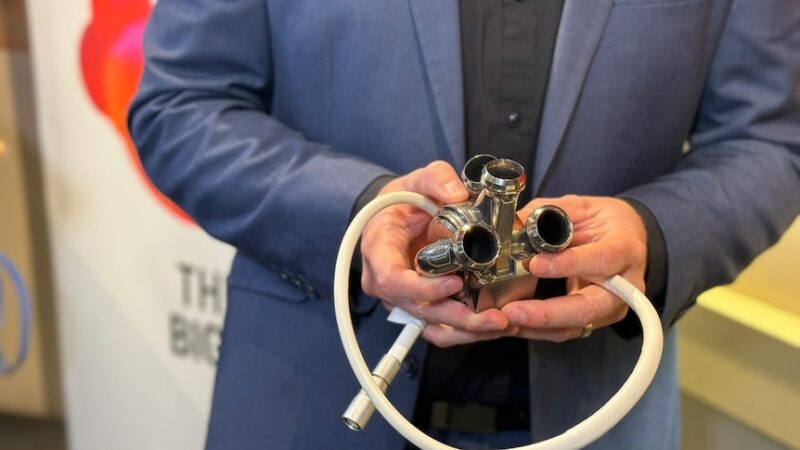Government announces $50m grant for Australian scientists designing world’s first long-term artificial heart

Jayden Cummins caught the flu at 46 – it changed his life forever.
The virus attacked his heart, which became so inflamed he was left in end-stage heart failure.
“[The flu] made my heart deteriorate to such a point that I was actually operating at about 7 per cent.”
The Sydney filmmaker was implanted with a Left Ventricular Assist Device (LVAD) for about 15 months, before receiving a heart transplant.
“I was living as a cyborg with that beautiful machine and it was able to get me to the point where I was fit enough and healthy enough that I actually then survived a heart transplant,” he says.
But many patients with advanced heart failure die while waiting for a heart transplant.
Australian researchers are hoping to change that, by developing a new generation of artificial hearts.
An off-the-shelf heart
Bioscientist Dr Daniel Timms says his BiVACOR Total Artificial Heart will be a durable long-term alternative to heart transplants.
Instead of beating blood around the body like a normal heart, his device will “whoosh” the blood around by using magnetic levitation technology.
“What we’re doing here is use a spinning disk that essentially whooshes the blood around the body instead of beating it around,” Dr Timms said.
His invention began as a PhD project at the Queensland University of Technology more than two decades ago.
“To make these devices last for a very long time, we need to remove any kind of mechanical wear so that they’re extremely durable, and the way we do that is we use magnetic levitation technology.
“And that’s the analogy or the comparison to trains in Japan and China that are magnetically levitated.”
For Dr Timms and the team at the Artificial Heart Frontiers Program, the revolutionary project requires regular trips to the hardware store.
“We have a frequent flyer card with Bunnings, basically, because we go there a lot,” said Associate Professor Shaun Gregory, co-director of the Artificial Heart Frontiers Program at Monash University.
“It’s always funny when people come into our lab and see drill presses and bench grinders and parts from Bunnings.”
The “bunch of pipes” are used together to replicate the heart and cardiovascular system.
“That’s how we test our devices on a bench top.”
Professor Gregory says testing so far has demonstrated “tremendous results”.
“We take them through benchtop tests on the parts, obviously they’re not just from Bunnings, but much more sophisticated test loops than that.
“Then we take them through blood testing and we take them through a lot of preclinical other testing as well.”
The cardiovascular engineer says current artificial hearts try to mimic the “pumping” and “contracting” of a natural heart, “kind of like balloons”.
“Existing devices use balloons to replicate that. You can imagine a balloon inflating and deflating that many times, it’s going to wear out very quick.”
The new titanium hearts have been tested in animals so far but will be implanted in humans for the first time this year in the United States — and eventually in Australia.
It’s hoped the device will be an off-the-shelf long-term alternative to heart transplants, and eventually replace the need for donor hearts altogether.
Could it save lives?
Monash University’s Professor Gregory says patients who are waiting for a donor organ, which are in rare supply, need “another solution” to keep them alive, and allow them to live an active life, while waiting for a transplant.
Each year heart failure kills one in 50 Australians and 60,000 people end up in hospital for treatment.
Just 100 or so heart transplant procedures are performed each year.
“The challenge is the number of donor organs available just can’t meet the demand for heart failure,” says Dr Timms.
“Even the donor heart is not without its challenges with immunosuppressants and also availability. So we’re certainly looking to create a device that’s off the shelf and able to be implanted in a patient as soon as they need it.”
Professor Garry Jennings from the Heart Foundation of Australia says the new technology could be a “game changer”.
He says the difficulty in finding heart donors is “a very good thing” because it reflects a reduction in road accidents, but means the medical field “desperately” needs ways to ensure heart failure patients have an alternative.
“The availability of hearts for transplant has been a big problem. A lot of people have not been able to get the transplant before they have an untoward event.”
The federal government will provide $50 million in funding to support the development of these artificial hearts and other cardiac implants.
Scientists hope the government funding will help accelerate the program and allow devices to become available to patients within the next couple of years.
“We’ve been trying for a long time to find some way of getting a permanent kind of artificial heart to support people,” says Professor Jennings.
Transplant recipient Jayden Cummins says the new devices will make a big difference for future patients like him with heart failure.
“I just think it’s absolutely brilliant and it’s something that gives hope. Relying on donors is such a rare thing and they’re hard to come by.”
Having just celebrated the five year anniversary of his transplant, Mr Cummins says he feels “amazing” and has passed health checks with flying colours.
“I’ve got to watch my boy grow up and finish his HSC. I’ve had all that extra time with him that I really shouldn’t have,” he says.
A few months after Mr Cummins received the transplant, he met Sandra, “the love of my life”.
“We’re now engaged to be married … It’s just a privilege to be here. I take absolutely nothing for granted.
“And the thought of that being more readily available for other regular people like me is heartwarming. Excuse the pun. It’s amazing.”








